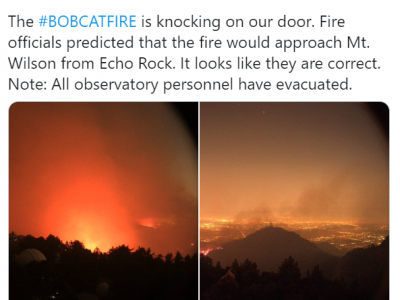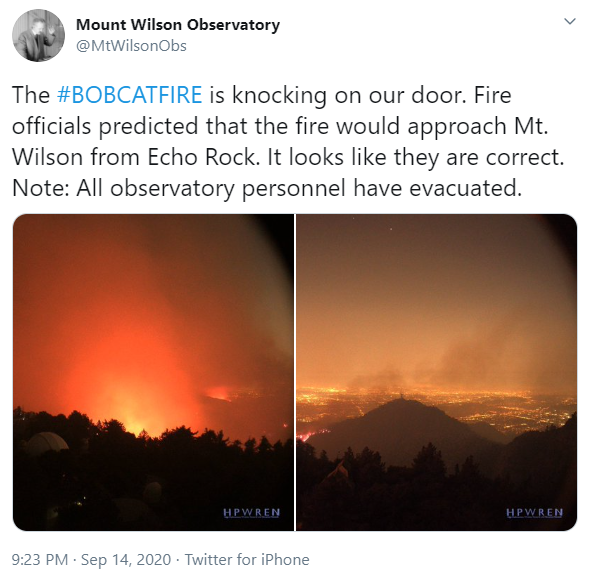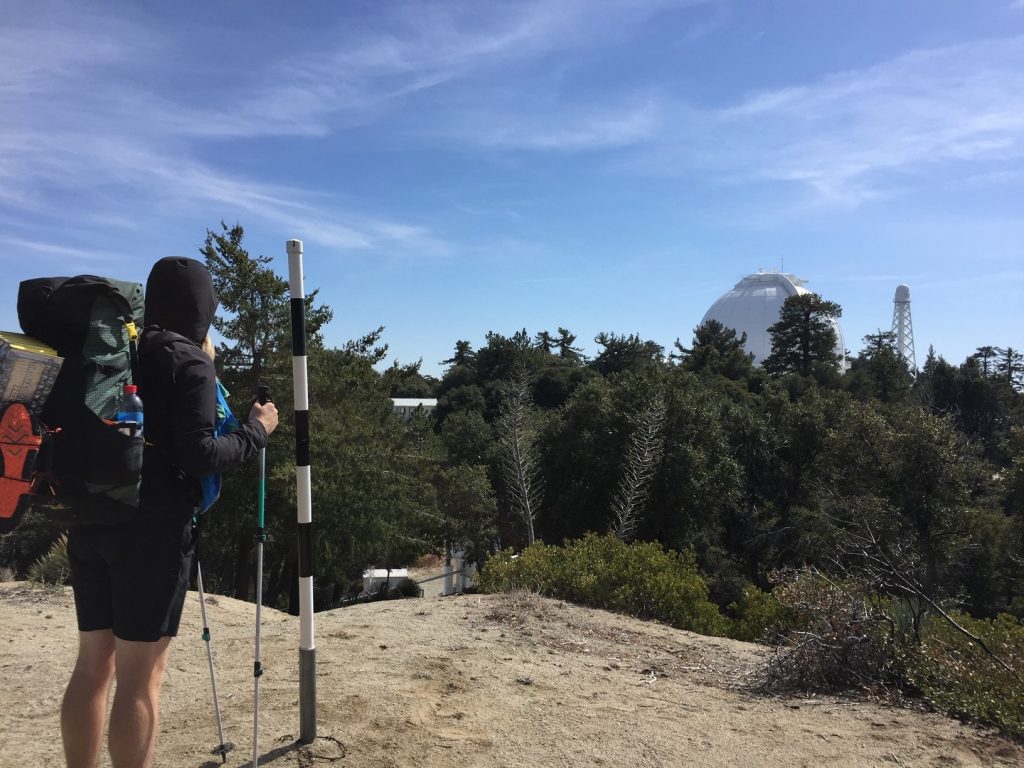
The Bobcat fire blazing in the San Gabriel Mountains is threatening lives and homes, forcing evacuation of communities in foothills clogged with acres of brush dried out by the hottest August ever recorded in California. For flatland Angelenos like me, the fires are both omnipresent and distant, sensed only by the hazy skies and smell of smoke. With windows kept shut, I’ve been tuned in to the Los Angeles Times’ wildfire map, SCAQMD’s Current AQI map, Twitter hashtags, radio updates, and other sources.
The flames are now coming for Mt. Wilson Observatory, a scientific and telecommunications hub overlooking Los Angeles where astronomer Edwin Hubble sat at a state-of-the-art telescope in 1924 and discovered our universe extended beyond the Milky Way galaxy.
Last night, the observatory’s Twitter account posted, “The #BOBCATFIRE is knocking on our door,” alongside a webcam image of ridgelines glowing red with flames. Local NPR affiliate KPCC tweeted last night that its radio broadcast might be disrupted as the fire encroached on its nearby transmitter. Today, the Los Angeles Times reported the fires were within 500 ft. of the observatory.
I was up at Mt. Wilson Observatory last year with two friends after a night camped out in a deep valley along the West Fork of the San Gabriel River (one of the country’s outstanding recreational trails). That morning, we climbed up a steep, dusty path to the top of a ridge where, on a clear day, you can see out across the Los Angeles basin, spotting ships in the Port of Long Beach and catching the shimmer of the Pacific between the Palos Verdes peninsula and Catalina Island.

Visitors to the observatory walk past an array of active and historic scientific observational equipment and drop in on exhibits detailing the many discoveries made here. I’d been to Mt. Wilson before, in my freshman year at UCLA, on a field trip for a yearlong course on the history of the universe. We learned how Southern California scientists here discovered the cosmos was expanding, a finding that underpins the Big Bang Theory of the universe’s creation.
At a time when life in Los Angeles has never felt smaller or more precarious, it seems fitting that our attention is now focused on the place where we found out just how tiny Earth’s place in the vast universe really is.
Having worked on climate change for all my professional life, I’ve spent a lot of time contemplating loss. It’s part of what motivated me to work on cutting carbon emissions in the first place, having visited the Sierras during drought years and seeing mountains bare of snow, wondering what would happen to our winters and the water supplies that feed our farms and cities. On a Christmas Day beach walk with my family last year, I took photos of waves lapping up against homes near San Diego, and the crumbling cliffs next to the Amtrak rail line.
Global warming is already taking so much. It’s getting too hot in some cities for summer baseball games to be played during the day. Even without the pandemic, the historic heatwave over Labor Day weekend would have spoiled barbecues, hikes, and beach days because it was simply too hot to be outside. Heat and wildfires cut short a season that Californians normally fill with family vacations as the Sierras, San Gabriels, coastal ranges, and other areas burned. Last month, wildfires tore through parts of the Santa Cruz mountains where I’d camped just two weeks before.
California is taking steps in the right direction on wildfires and climate: the U.S. Forest Service has an aggressive plan to manage fire risk in the San Gabriel Mountains, including prescribed burns, hazardous vegetation thinning, post-fire restoration, and programs to reduce risk near homes. The state’s groundbreaking climate policies advanced this summer with a new rule curbing emissions from diesel trucks and ships. And one of its most valuable companies, Google, announced this week that its investments in carbon offsets and clean energy had mitigated all its greenhouse gas pollution since the company was founded in 1998, as it committed to more ambitious policies.
Those efforts will have to counteract the decades we’ve spent suppressing fires in our forests and piling greenhouse gas emissions into the atmosphere from car exhausts and power plants, even as we build more homes in fire hazard zones. It doesn’t help that our president doesn’t seem to care about the science and a committed group of appointed officials in federal agencies have waged a four-year war on our country’s climate policies, often with industry encouragement. Nor that national television broadcasts rarely mentioned the role of climate change in heat emergency and wildfire events this summer.
California needs to go much further: this month, our state legislature stalled yet again on legislation to build more housing in areas least at risk from wildfires. Local officials continue to make decisions that prioritize fossil-fuel powered cars, a leading (and growing) source of carbon pollution.
If we can’t get a handle on the problem, more lives, ecosystems, and our cultural heritage will be at risk.
The post “Knocking on Our Door”: Wildfires Threaten Mt. Wilson Observatory and San Gabriel Foothill Communities appeared first on Legal Planet.
By: Daniel Melling
Title: “Knocking on Our Door”: Wildfires Threaten Mt. Wilson Observatory and San Gabriel Foothill Communities
Sourced From: legal-planet.org/2020/09/15/knocking-on-our-door-wildfires-threaten-mt-wilson-observatory-and-san-gabriel-foothill-communities/
Published Date: Tue, 15 Sep 2020 20:50:37 +0000
Vist Maida on Social Me
Website Links
Maida Law Firm - Auto Accident Attorneys of Houston, by fuseology
No comments:
Post a Comment